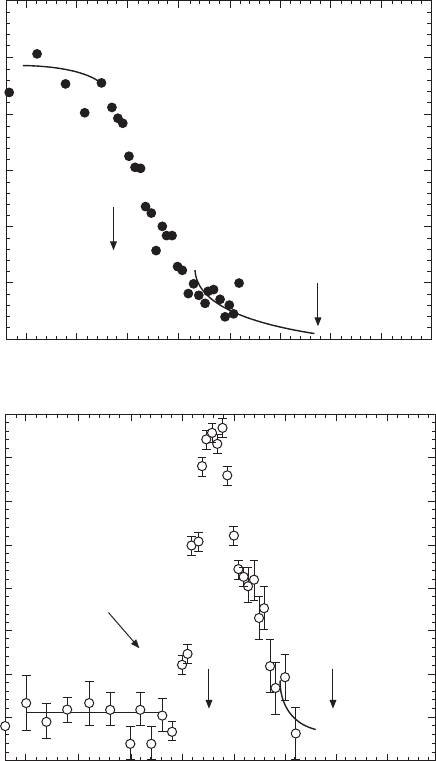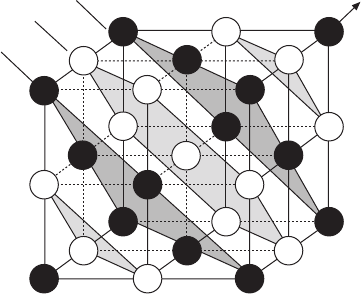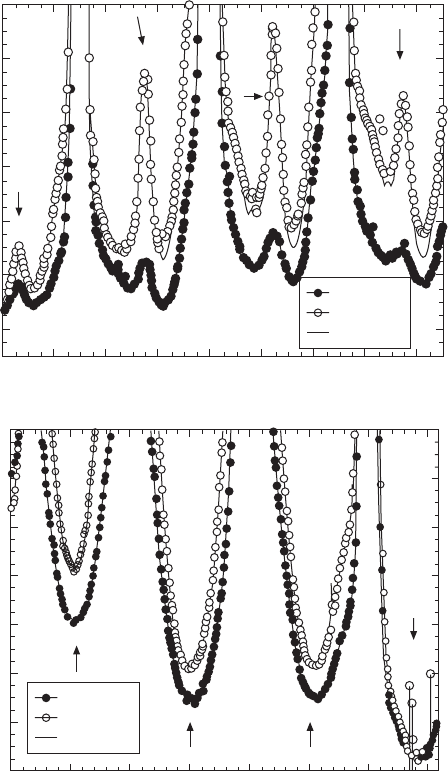Zuo-Guang. Ye Advanced Dielectric Piezoelectric and Ferroelectric Materials: Synthesis, Characterisation and Applications
Подождите немного. Документ загружается.


Handbook of dielectric, piezoelectric and ferroelectric materials400
(≈ 80K) of Pb(Mg
1/3
Ta
2/3
)O
3
and of PMN is indicative of the strong influence
of the Nb(Ta)–O chemical bonds. However, only one of the B cation is a
ferroactive atom, and it was admitted that Mg in PMN, Sc in PSN or Zr in
PZT are less involved in the ferroelectricity (Chen et al., 1995, and references
therein) and that the associated oxygen octahedra are only weakly distorted
(if any). Besides, Nb cations are known to be displaced along the <111>
directions with respect to their oxygen octahedra (about 0.1Å) from extended
X-ray absorption fine structure (EXAFS) (Prouzet et al., 1993). However
results from nuclear magnetic resonance (NMR) measurements (Laguta
et al., 2003) seem to be contradictory as they indicate that Sc is the ferroactive
ions. Ti cations are also considered to be displaced but there are more ‘versatile’
in their direction than Nb cation. Indeed it was shown in Pb(ZrTi)O
3
(PZT)
(Grinberg et al., 2002) and PbSc
1/2
Ta
1/2
O
3
–PT (PST–PT) (Frenkel et al.,
2004) that the direction of Ti cations gradually changes from [111], as in
BaTiO
3
, to [001] direction, as in PbTiO
3
, with increase of Ti. In a way Ti
plays the same role as the polarisations in MPB systems by rotating from a
rhombohedral-like direction to a tetragonal-like one (see below). Actually
the displacement of Pb cations, which are considered as the most active ions,
are somewhat governed by the B cation distribution via coupling through the
oxygen cages. A Pb cation inside an ordered distribution of B cation should
be displaced differently from when these B cations are randomly distributed
(Grinberg et al., 2002). The role of B cation is thus also very important.
It is interesting to observe that inside the ferroelectric rhombohedral phase
of PSN and PMN–PT, the [100], i.e. tetragonal-like displacement of lead
atoms, together with the [111], i.e. rhombohedral-like displacement of B
cation (Fig. 6), composes a global polarisation which stands evidently out of
the [111] and [100] directions and inside a plane of symmetry corresponding
to a monoclinic Cm phase: the local polar order of the ferroelectric phase
results from a competition between both types of displacements associated
[001]
Polarisaton
of lead
Polarisation of
Ti/B
1
B
2
cations
[111]
[110]
14.6
Schematic decomposition of local polarisation in PSN and PMN–
P
T
: the polarisation due to [100] displacements of lead atoms and the
polarisation of B cations along [111] rhombohedral direction
compose into a resulting polarisation inside a
Cm
monoclinic plane.
WPNL2204
From the structure of relaxors to the structure of MPB 401
to the cations and prefigures the long-range monoclinic polar phase which is
observed in the MPB phase, as we discuss below.
From this set of experiments we obtain this preliminary physical picture:
at high temperatures isotropic but highly anharmonic dynamical displacements
of lead are observed along a spherical shell. Upon cooling, these displacements
gradually slow down and begin to correlate below the so-called Burns
temperature T
B
: it is tempting to call PNRs these ‘regions’ of correlation,
forgetting a possible discussion about the pertinence of this notion of well-
delimited domains with abrupt boundaries, etc.
Keeping this idea in mind, we have to consider that whereas the PNRs
result from the intra-correlation of displacements, close to T
B
, the inter-
correlation between the PNRs is weak. When these correlations get strong
enough at lower temperature, dynamical displacements are evidenced which
are no more along a spherical shell but get more and more anisotropic along
the <100> direction and the associated diffuse scattering appears in the
diffraction experiments below a T* temperature. T* may correspond to a
local order–disorder phase transition related to Pb atoms (Dkhil et al., 2002),
and, by analogy with magnetic systems, may be related to a crossover from
a Heisenberg to an Ising-like transformation (Stock et al., 2004).
In the case of PMN these displacements freeze below T
F
(∼200K), the
intensity of the associated diffuse scattering becomes constant (Fig. 14.7a),
and no long-range polarisation appears. In the case of PSN and PMN with
5% and higher concentration of PT, the temperature evolution of the diffuse
scattering intensity gets a critical evolution (Fig. 14.7b): a [111] long-range
polarisation appears below a critical temperature T
C
. The same feature was
also evidenced in PZN (Bing et al., 2005). However below T
C
the short-
range component of the polarisation (perpendicular to (111)) manifests itself
by a non-zero intensity of the diffuse scattering at the lowest temperature.
A contradiction emerges from the mere assimilation of the local order
which develops below T
B
to the notion of PNRs: this identification should
lead to a monoclinic symmetry for the PNRs in opposition with the model of
rhombohedral local order proposed by Mathan et al. in PMN and the intuitive
idea of nucleation from the PNRs of the rhombohedral phase observed in
PSN or in PMN–PT. It is noteworthy that when de Mathan et al. did their
modelling for the diffuse scattering they found that either the rhombohedral
or the orthorhombic symmetry may explain the diffuse scattering observed
on the diffraction patterns and thus the PNRs, but at this time, as it was
known that an electric field induces a rhombohedral phase at low temperature
in PMN, it was admitted that the PNRs should be of rhombohedral symmetry
and the orthorhombic symmetry was discarded. Another observation related
to this question is the existence of a (long-range) rhombohedral phase in
PMN at low temperature when an electric field is applied above a critical
value (see Section 14.6). This phase arises from nucleation (Vakhrushev
WPNL2204

Handbook of dielectric, piezoelectric and ferroelectric materials402
et al., 1997) and percolation of nanodomains which could be identical to the
PNRs. We will see in Section 14.3.3. that this question is rather complex and
in fact not completely understood, but for the moment we ignore these facts
and consider the PNRs to be the local polar order evidenced by the experiments
described in this section.
Intensity (arb. units)
600
500
400
300
200
100
0
T
F
T
*
100 150 200 250 300 350 400 450 500
Temperature (K)
100 150 200 250 300 350 400 450 500
Temperature (K)
T
F
T
*
T
c
800
700
600
500
400
300
200
100
0
14.7
(a) Diffuse scattering in PMN: below a (extrapolated)
temperature
T
* the diffuse scattering appears; it saturates below a
T
F
temperature. (b) Diffuse scattering in PMN–10%PT: below
T
* the
diffuse scattering gets a critical behaviour at
T
C
; below
T
F
it gets a
non-zero saturated value.
WPNL2204
From the structure of relaxors to the structure of MPB 403
Raman experiments by Toulouse and coworkers (Svitelskiy et al., 2003,
2005) as well as neutron inelastic experiments by Shirane and coworkers
(see references in text below), Vakhrushev and coworkers (Naberezhnov et
al., 1999) and Hlinka et al. (2003) showed above T
B
a soft TO mode with
increasing (when cooling) couplings to local mode associated to spherical
displacement of lead and tunnelling of niobium atoms. This soft mode could
condense at T ≈T*, but below T
B
a drop of the transverse optic (TO) phonon
branch into the transverse acoustic (TA) one at a non-zero wave vector q and
its strong damping below a sufficiently small q vector were related to the
condensation of the PNRs. This condensation inhibits the propagation of the
long-wavelength TO polar modes when the phonon wavelength is comparable
to the size of the PNRs. This anomaly has been called the ‘waterfall effect’
(Gehring et al., 2000; Wakimoto et al., 2002). A central peak appears
(Naberezhnov et al., 1999), associated to the PNRs, i.e. polar correlated
atomic fluctuation below T
B
, which progressively couple between each other
and slow down, becoming static below T
f
.
The PNRs being polar, they couple to the polar TO phonon mode, which
in turn can serve as a microscopic probe of the PNRs. However, based on
analogous experimental observations on the classic ferroelectric BaTiO
3
(Shirane et al., 1970) and reinvestigation of neutron experiments, some doubt
on the connection of the PNRs and the waterfall effect was expressed (Hlinka
et al., 2003). An explanation based on classic interference of line shape
anomalies due to the coupled acoustic and optic branches without any ad hoc
assumption was proposed (Hlinka et al., 2003). This controversy is complicated
by the fact that different probes are used to investigate the soft mode: neutron
vs. infra red and Raman techniques. Indeed these techniques use phonons
with different wave-vectors; therefore, the TO and TA modes, their over-
and/or under-damping and their possible coupling in neutron data are not
necessary similar to those of IR for instance. In order to reconcile the
observations, the ‘phase-shifted model’ (Hirota et al., 2002) was introduced.
In this model, a PNR consists of two components. The first one corresponds
to the polar soft mode and thus gives rise to the spontaneous polarisation
within the PNRs. The second one is associated with the acoustic mode and
corresponds to a uniform displacement of all atoms inside the PNR; a TO–
TA coupling is therefore possible. In Section 14.3.3 we will see that this
picture is consistent with the mechanism proposed from diffuse scattering
experiments.
14.3.2 Chemical order
As pointed out in the introduction it was recognized very early that ‘textbook’
PMN was not chemically homogeneous and the first model of explanation
for diffusivity of dielectric properties was based on a T
C
dependence of the
WPNL2204

Handbook of dielectric, piezoelectric and ferroelectric materials404
local chemistry. Later observations by electronic microscopy (Krause et al.,
1979; Randall et al., 1986) were reported: the absence of temperature
dependence of superstructure intensities assigned a chemical origin and these
peaks were interpreted as arising from nanodomains with a non-stochiometric
composition Pb(Mg
1/2
Nb
1/2
)O
3
. This local composition results in negative
unbalanced charge which have to be compensated by rich Nb zones with
positive charge in order to get a global Pb(Mg
1/3
Nb
2/3
)O
3
concentration.
The size of these nanoregions should result from equilibrium between
elastic and electric energies. The associated static charges induce the creation
of random electric fields which are at the origin of modern interpretations
for the non-growing of polar order at low temperature in PMN. A simple
picture of cationic distribution was straightforward (Fig. 14.8) and was denoted
the 1:1 model due to the alternating Nb or Mg [111] planes in the structure.
Latter, observation of equivalent superstructure peaks in PSN seemed to
confirm this structural model because in this compound it is more ‘natural’
since the global 1/2:1/2 stochiometry instead of 1/3:2/3 does not imply an
unbalanced charge.
However, an alternative structural model in PMN proposed by Davies and
Akbas (2000) and Chen et al. (1989) was inspired from the structure of
compounds such as Ba(Mg
1/3
Nb
2/3
)O
3
and, Sr(Mg
1/3
Nb
2/3
)O
3
in which the
ordered
Pb(B B )O
1/2 1/2
3
′′′
regions are electrically neutral due to random
occupation of B
2+
and B
5+
on the B′ site whereas the B″ site is only occupied
by B
5+
, leading to a global formula
Pb[(B B ) ]O
2/3
2+
1/3
5+
1/2
5+
3
Β
12/
. With such a
model, a global 1:2 stoichiometry of B cation is retained within the sample.
The explanation for nanometric size of these ordered domains within this
model is based (Viehland and Li, 1993) on the competition of stability between
perovskite ABO
3
and pyrochlore structure A
2
B
2
O
7
: above a nanometric critical
B
B′
B
[111]
14.8
Ordered structure 1:1, perpendicular to [111] direction, of
PbB′B″O
3
; only B cations are shown.
WPNL2204

From the structure of relaxors to the structure of MPB 405
size the ordered perovskite region transforms into parasitic pyrochlore
phase.
In the case of PSN the situation appears to be simpler. Indeed since
pioneering work by Setter and coworkers (Chu et al., 1995a,b), it is well
known that due to a high-temperature (1510K) order–disorder phase transition
Sc/Nb can diffuse through the structure and arranges in a structural scheme
probably identical to that depicted in Fig. 14.8. This is due to cationic radius
and valency with close values (0.74Å, 0.69Å and III, V for Sc and Nb,
respectively), as systematic investigations of cationic order of PbBB′O
3
oxide
have shown. Ordered PSN displays much lowest value of real permittivity
with lowest relaxation than disordered compounds (Fig. 14.9). The lead
vacancies as well as the substitution of barium for lead (6% on Fig. 14.9)
strongly increase the diffusivity of the dielectric behaviour. Notice, however,
that in all cases considered, a well-defined cubic–rhombohedral transition is
found.
Persistence of relaxation in an ordered compound is against the intuitive
idea on the need of disorder for the dielectric relaxation to appear. TEM and
ε′
20000
16000
12000
8000
4000
0
100 150 200 250 300 350 400 450
T
(K)
Ordered PSN
PBSN
PSN vacancies
PSN disordered
14.9
Temperature dependence of real permittivity in disordered PSN
(
T
C
= 380(±5)K), ordered PSN (
T
C
= 350(±5)K), lead vacancies PSN
(
T
C
= 365(±7)K) and PSN with 6% of Ba on Pb site (
T
C
= 375(±6) K);
T
C
is deduced from X-ray measurements.
WPNL2204

Handbook of dielectric, piezoelectric and ferroelectric materials406
X-ray diffraction have shown that the so-called ‘ordered’ or ‘disordered’
PSN is only an unrealistic limit case: indeed, measurement of {h + 1/2,
k + 1/2, l + 1/2} superstructure peaks intensity allows one to calculate a
simplistic coefficient:
S
I
I
I
I
2
surst
Bragg
observed
surst
Bragg
S=1
=
where (I
surst
/I
Bragg
)
S=1
is a calculated value with hypothesis of a totally ordered
compound, whose value is roughly the same whatever the model of order
one considers. S is therefore a rough measurement of volumic ratio of ordered
regions.
In PSN, the experimental value for the ordered compound is never higher
than ≈ 0.92 instead of 1. On the other hand, although the S value of disordered
PSN which results from quenching is equal to zero, a weak value is always
observed (Malibert et al., 1997). One should also take into consideration the
coherent length ξ of the local order which is easily deduced from profile
fitting of superstructure peaks and is in a simplistic way a ‘typical’ size for
ordered regions: in a so-called ‘ordered’ PSN, one gets a typical value of ξ
= 20 nm, whereas in the case of PMN (in which cation ordering cannot be
modified by thermal annealing), the typical size of ordered regions is about
5nm and S is less than 20%.
Weak (less than 5% of Bragg peak in PMN; see Fig. 14.10) supplementary
{h + 1/2, k + 1/2, 0} peaks have also been found in PMN and PSN. Moreover,
in PMN a temperature dependence of at least between 300K and 10K was
evidenced, suggesting possible structural origin from displacement correlations.
This hypothesis is reinforced by a non-monotonic evolution of intensity with
scattering vector. Moreover, a condensation of the M
3
phonon mode due to
the contribution of local antiferroelectric order (Takesue et al., 1999; Miao
et al., 2001) was proposed to explain these additional superstructures. In
PST (a compound that behaves very similarly to PSN, with tantalum instead
of niobium) the {h + 1/2, 0, 0} peaks were observed at room temperature by
transmission electron microscopy (TEM) (Randall et al., 1986): an
interpretation based on the existence of tetragonally distorted ordered zone
was proposed (Caranoni et al., 1992); however these peaks are absent in
both PSN (Malibert, 1998) and PMN(Dkhil, 1999) (Fig. 14.10).
The associated domain size deduced from full width at half maximum
(FWHM) is the same order of magnitude as for the {h + 1/2, k + 1/2, l + 1/2}
peaks and is about 5nm in PMN and disordered PSN. Depero and Sangaletti
(1997) have proposed a tetragonal distortion of cubic lattice cell with rotation
of octahedral to explain the existence of these superstructure peaks. In fact
WPNL2204

From the structure of relaxors to the structure of MPB 407
neutron experiments showed afterwards the absence of such tiltings, but the
idea of a tetragonal distortion for the regions of ordered cation appeared to
be correct and was demonstrated by careful analysis of the diffuse scattering
(see Section 14.3.3).
Intensity (arb. unit)
14000
12000
10000
8000
6000
4000
2000
1/2 1/2 0
3/2 3/2 0
5/2 5/2 0
7/2 7/2 0
T
= 300 K
T
= 10 K
16000
14000
12000
10000
8000
6000
4000
2000
T
= 300 K
T
= 10 K
0.4 0.8 1.2 1.6 2 2.4 2.8 3.2 3.6
h
–4 –3.5 –3 –2.5 –2 –1.5 –1 –0.5
14.10
Q-scan along [
hh
0] and [
h
00] in PMN at
T
= 300K and
T
= 10K
(beamline ID15A at European Synchrotron Radiation Facility (ESRF)
showing the {
h
+ 1/2,
k
+ 1/2, 0} superstructure peaks; no {
h
+1/2,
0, 0} peaks are detected.
WPNL2204
Handbook of dielectric, piezoelectric and ferroelectric materials408
In summary, many observations demonstrate the existence in PMN and
disordered PSN of CORs with typical sizes of 5nm whose composition does
not change with temperature. Some other observations (see below) suggest
that, at least at 300K and below, these regions are tetragonally distorted, and
that this distortion probably disappears at higher temperature.
14.3.3 Interaction between CORs and PNRs: diffuse
scattering experiments
As noted in Section 14.2, the first observation of diffuse scattering in PMN
was carried out by X-ray and neutron powder diffraction. Afterwards
Vakhrushev et al. (1994) were the first to perform comprehensive sets of
experiments in single crystals, gaining deep insights of the origin of this
phenomenon. Later on, several other teams, in particular those of Shirane
and Toulouse, contributed to these types of study.
In particular, diffuse scattering located around <h00> reflections with
extension along 〈110〉 directions produces the so-called ‘butterfly-shape’
diffuse scattering. Such anisotropic diffuse scattering was observed in many
types of relaxors, PMN, PSN, PZN and MPB systems such as PZN–PT.
Diffuse scattering arises from local departures from the average structure
and even if the correct model for this butterfly-type diffuse scattering is still
a matter of debate, it is generally attributed to the formation of polar correlations.
It has been, for instance, suggested that the rather localised rod-type
diffuse scattering indicates planar nano-domains which are oriented normal
to the 〈110〉 crystal directions and contain correlated Pb
2+
displacements.
However, such ionic displacements cannot be described as ‘pure polarisation’
and there is a large contribution corresponding to the elastic deformation as
proposed in the phase-shifted model (Hirota et al., 2002). Taking into account
the elastic deformation the appearance of the PNRs should create severe
host-lattice elastic distortions. Therefore, the appearance of such elastic defects
should produce very strong diffuse scattering which is well known in the
case of phase precipitation through the so-called Huang scattering.
In this framework, it has been demonstrated that the observed anisotropic
diffuse scattering can be very well reconstructed by a strain field produced
by defects of tetragonal symmetry. In other words the source of the anisotropic
diffuse scattering comes from tetragonal clusters which are responsible, all
around them, of the appearance of static and elastic deformations of the host-
matrix.
It is worth noting that in contrast to previous conclusions, in the above
approach the anisotropic diffuse scattering, induced by the tetragonal clusters,
is not necessarily related to the PNRs. In fact, there is rather a clear correlation
between the anisotropic diffuse scattering and the CORs. Indeed, the weakening
of the superstructure spots by doping PMN with PbTiO
3
results in the
WPNL2204
From the structure of relaxors to the structure of MPB 409
simultaneous decrease of the intensity of the anisotropic diffuse scattering
(see Fig. 14.24 of Section 14.4.4). This observation may be understood by
considering that the tetragonal clusters are actually the CORs.
Nevertheless, one has to keep in mind that another way to describe the
anisotropic diffuse scattering is to consider PNRs through correlated lead
displacement in agreement with the structural data shown in Section 14.3.1
and recent calculations on PZN (Welberry et al., 2005) . Therefore, a possible
scenario which satisfies the above conclusions consists of coupling the CORs
to the PNRs, assuming that the PNRs coincide at least to some extent with
the CORs. Around such defect regions, strong (strain and electric) fields are
expected and as the matrix is highly deformable and polarisable, they can be
considered as the ‘embryos’ for the nucleation of PNRs. The PNRs are
therefore both pinned and driven by the chemical ordering and coexist with
the matrix, which can adopt a different symmetry. However as in the traditional
pictures of nucleation, several types of defects can be at the origin of the
low-temperature nucleus: for instance Laguta et al. (2004) observed PNRs in
disordered part of samples, which obviously do not nucleate on CORs.
This picture arises also from the recent simulations by Burton et al. (2006)
who showed that the polarisation and the polarisation fluctuations in relaxors
are strongly enhanced inside the CORs. Particularly in the temperature range
where they appear, polar nanoregions have not already grown and they are
essentially the same as CORs (Fig. 14.13 below). They also showed that
arbitrarily increasing the magnitudes of local electric fields, by increasing
the chemical disorder, broadens the dielectric peak, and reduces the ferroelectric
transition temperature, while sufficiently strong local fields suppress the
transition as in PMN.
Temperature, electric field and pressure effects are coherent with the
above scenario. In particular, the appearance on cooling of diffuse scattering
at a temperature T* well below T
B
(which marks the appearance of the
PNRs) shows the importance of the elastic contribution (otherwise, T* should
be equal to T
B
). Recent experiments in PMN conducted by our group have
associated this T* to strain released with the appearance of a static component
of the PNRs (Dul’kin et al., 2006). Furthermore Toulouse and coworkers
(Svitelskiy et al., 2005) suggested a tetragonal symmetry around T* which,
as the Raman lines are normally forbidden and arise from CORs, might
occur only inside the CORs. A plausible explanation is that the static component
of the PNRs is associated to the pinning of the dynamic PNRs by the tetragonal
CORs.
Application of pressure (Fig. 14.11) also leads to the disappearance of the
anisotropic diffuse scattering in relaxors: this is consistent with the above
scenario where the average crystal structure and the PNRs adopt the same
crystal structure, which in turn effectively suppresses the deformation between
the host-matrix and the PNRs (Chaabane et al., 2003b). In this framework,
WPNL2204
